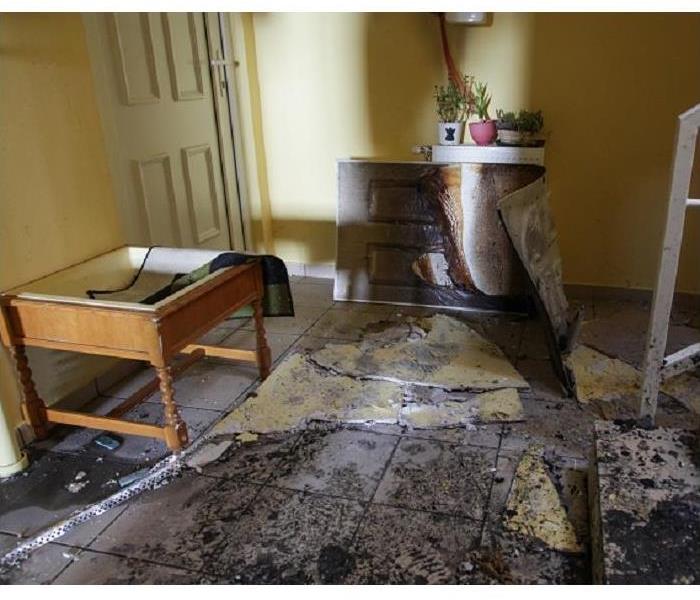How Does SERVPRO Decide What Happens First When a Fire Takes Place?
10/5/2020 (Permalink)
 Fire damage restoration requires technical knowledge and specialized equipment. SERVPRO has what it takes to restore your home.
Fire damage restoration requires technical knowledge and specialized equipment. SERVPRO has what it takes to restore your home.
Our Technicians Put Safety First and Know How to Assess What Mitigation Needs to Happen Initially in Milton Homes after a Fire
In 2018 approximately 387,00 residential fires took place, according to the Insurance Information Institute (iii). Of those fires, 276,500 were single-family homes, 86,500 were apartment fires, and 24,000 were other types of dwellings. These fires resulted in 8,286 million dollars of property loss, up 2% from the previous year. Fires like this take place every year in Milton. Often families are left displaced and at a loss at what to do next.
What Gets Managed First During Fire Restoration?
When a home has fire damage in the Milton area, safety issues get addressed first. Repair and restoration cannot take place until the building is secure. SERVPRO knows what the potential hazards are and where to look for them. Our technicians do a scope of the area to determine safety concerns. These are dealt with before emergency mitigation and restoration starts. Each job is different, but there are specific things techs look for, and these include:
- Asbestos
- Contamination category of water (from firefighters)
- Electrical shock hazards and systems
- Gas leakage risks
- Lead, often in paints
- Off-gassing during combustion
- Slip or fall hazards
- Structural damage
These issues must all be dealt with before SERVPRO crews can begin to restore the home.
How Are Safety Hazards Dealt with by Technicians?
If any concerns need mitigating, there are protocols in place to manage the situation. With electrical issues, the power may have to be turned off at the source. The same process goes for other utilities as well. If structural components are compromised, they may need temporary support put in place or removed altogether. We have certified biohazard removal technicians who can handle hazardous material removal and disposal as mandated by law. Our technicians wear respirators and use air scrubbers to mitigate poor air quality.
What Determines Which Fire Residue Strategies Get Used During Restoration?
Our Institute of Inspection, Cleaning and Restoration Certification (IICRC) certified and Fire and Smoke Restoration Technicians (FSRT) use their training and experience to examine the smoke residue present. They then choose the appropriate methods and products to clean impacted surfaces. They consider several things when putting a plan in place, including how the fire, smoke, and soot swept through the home. The conditions during the fire and the materials consumed are also part of the equation. There are different types of soot as a result that require specific cleaning methods. One room alone, such as a kitchen, can have more than one residue type from the fire damage. To clean properly, the FSRTs do the following:
- Determine the kind of soot – wet, dry, or protein-based
- Use inconspicuous spots to test cleaning methods and products
- Implement the actions decided upon
- Clean each impacted surface area so restoration efforts can begin
When Does Water Damage Cleanup Take Place?
Our IICRC techs attack water intrusion before fire damage cleanup begins. Water is very corrosive and can destroy building materials rapidly. If left standing, mold develops quickly. Before moving on to fire residue cleanup, the crews deal with water extraction using pumps and other extraction tools. Contaminated water gets contained and treated with EPA-registered antimicrobials. Structural drying is the next step using air movers and dehumidifiers.
The Smell is Awful – Does SERVPRO Handle That?
Deep cleaning and negative pressure air scrubbers can take care of much of the foul odor. Removing charred and burnt items helps immensely too. But the smell still often lingers from the smoke. Soot particles, the smoke residue that has settled, can sink into the tiniest nooks and crannies. Our technicians work diligently towards eliminating the odors. We use advanced techniques that neutralize the scent-bearing particles by chemically altering those particles. This process can include:
- Enzymatic Products
- HVAC ductwork cleaning
- Hydroxyl Generators
- Ozone Machines
- Thermal Fogging
- Time released pellets if needed
Fire damage in Milton can leave a house in shambles. Even if the fire is contained to one room, smoke residue gets carried throughout the entire home. Professionally trained crews are needed to restore the house to preloss condition. At SERVPRO, our goal is to leave your home, “Like it never even happened.”
We understand, as homeowners ourselves, how even small disasters can upset your family. We arrive fast to the scene and start putting a plan in place immediately. Once all safety issues are taken care of, we move on to cleaning and restoration. If it can be restored rather than replaced, that is the option we prefer, saving you money and preventing a loss of precious items. Not everything in a fire can be saved, but we do our best to help you decide what gets salvaged.
Contact SERVPRO of Sullivan and South Ulster Counties at (845) 791-7647 for professional fire damage service. We’re Faster To Any Size Disaster.






 24/7 Emergency Service
24/7 Emergency Service